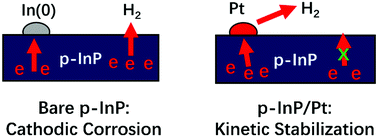Investigations of the stability of etched or platinized p-InP(100) photocathodes for solar-driven hydrogen evolution in acidic or alkaline aqueous electrolytes†
Abstract
The stability of p-InP photocathodes performing the hydrogen-evolution reaction (HER) has been evaluated in contact with either 1.0 M H2SO4(aq) or 1.0 M KOH(aq), with a focus on identifying corrosion mechanisms. Stability for the solar-driven HER was evaluated using p-InP electrodes that were either etched or coated with an electrodeposited Pt catalyst (p-InP/Pt). Variables such as trace O2 were systematically controlled during the measurements. Changes in surface characteristics after exposure to electrochemical conditions as well as electrode dissolution processes were monitored using X-ray photoelectron spectroscopy (XPS) and inductively coupled plasma mass spectrometry (ICP-MS). In either H2SO4 or KOH, etched p-InP photoelectrodes corroded cathodically under illumination, forming metallic In0 at the electrode surface. In contrast, electrodeposition of Pt kinetically stabilized illuminated p-InP photocathodes in both H2SO4 and KOH by inhibiting the cathodic corrosion pathway. Notably, when held at 0 V vs. the reversible hydrogen electrode (RHE) in 1.0 M H2SO4(aq), p-InP/Pt exhibited a stable current density (J) of ∼−18 mA cm−2 for >285 h under simulated 1 Sun illumination. The long-term current density vs. potential (J–E) behavior at pH 0 and pH 14 of p-InP/Pt photocathodes correlated with changes in the surface chemistry as well as the dissolution of p-InP. In acidic media, the J–E behavior of p-InP/Pt photocathodes remained nearly constant with time, but the surface of a p-InP/Pt electrodes gradually turned P-rich via a slow and continuous leaching of In ions. In alkaline electrolyte, the surface of p-InP/Pt electrodes was passivated by formation of an InOx layer that exhibited negligible dissolution but led to a substantial degradation in the J–E characteristics. Consequently, changes in the catalytic kinetics and surface stoichiometry are both important considerations for determining the corrosion chemistry and the long-term operational stability of InP photoelectrodes.



 Please wait while we load your content...
Please wait while we load your content...